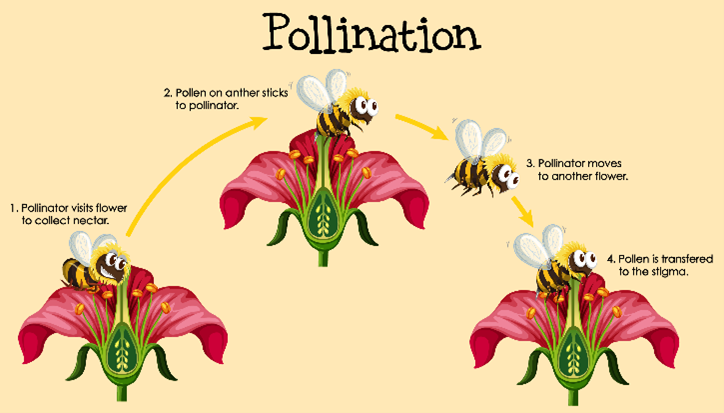
Did you know that 90% of the earth’s plant species rely on pollinators to reproduce? (Planet Bee, 2021) Pollination is the process of pollen being transferred from one flower to another, via a pollinator. Bees are not the only pollinator on earth, but they are essential ones. This short blog focuses on Solitary Bees and why we need them!
The United States Department of Agriculture (USDA) estimates that pollinators like bees and butterflies help pollinate approximately 75% of the world’s flowering plants. They also support the production of 87% of the world’s leading food crops.
Without bees, we wouldn’t have plants, and plants provide:
- One-third of our food supply (fruits, vegetables & nuts)
- Half of the world’s oils, fibres and other raw materials
- A large number of medicines
- Food and shelter for wildlife
- Clean and filtered oxygen
As well as producing all of this, plants also absorb CO2, effectively slowing down climate change. Plants also prevent soil erosion too!
How can we help protect this species?
Since 1930 the UK has lost 97% of its wildflower meadows (Kew, 2017), an important food source for bees. Furthermore, forecasts are predicting between 26,000 and 27,000 new houses to be built in the UK in 2022 (Built environment committee, 2021), meaning even more natural habitat for bees is being destroyed.
You may have seen on some farms, strips of wildflowers growing in between crop fields. Habitats such as these are brilliant for pollinators, who can efficiently travel to a higher quantity of flowers in a close surface area.
In addition to this, unreasonable fear of bees may also be having a detrimental effect on the destruction of colonies. People have developed a fear of being stung by Honeybees, understandably due to the pain associated! It is essential to note that honeybees will not sting as a hobby, they will only do so in fear. When a Honeybee stings it will decease due to the sting being lodged in human skin and when it flies away, the sting remains stuck and pulls away from its abdomen. Other bees such as Bumble Bees and Solitary Bees do not die when they sting. Bumble Bees have a smooth sting which is easy for them to remove, and Solitary Bees are non-aggressive. The males do not have stings and the females usually have a weak sting that would not normally be strong enough to penetrate the skin.
How can you create a suitable habitat for bees?
Simple – say no to the mow! Now obviously no one expects you to abandon your garden, (even though the bees will love you if you do!) but maybe think about leaving a patch at the back or in the corner for wildflowers to grow.
Here are 6 principles of meadow management for you to get started:
- Reduce soil fertility. As a general rule, unimproved soil supports the highest diversity of wildflower species.
- Encourage grasses to grow strongly.
- Conserve the wildflowers.
- Control and discourage unwanted species such as various weeds from dropped seeds.
- Encourage a wider range of species by adding new plants and bulbs
- Eliminate pesticides.

Take a look at the products we sell which can help you create and manage your bee habitat.
Wooden Bee nesting tubes (pack of 50)
These specially drilled wooden tubes are ideal for mason bees, leafcutter bees and other overwintering insects. Use them to top up an existing bee box or make your solitary bee nester.
Pack of 50 includes a range of sizes from 5-12mm in diameter (sizes 7-10mm are best for solitary bees, but other insects will use smaller and larger sizes).
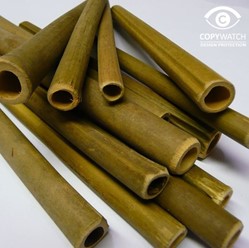
Or if you’re feeling slightly more adventurous…
Conservation Solitary Beehive.
This professional, high specification solitary beehive is particularly aimed at conservation professionals, orchard and fruit growers and pro-landscapers. It is made from solid FSC certified timber and provides ideal space for up to 1000 bee cells.
Three different solitary bee nesting systems are incorporated into one unit:
- First, professional stackable beehive trays on either side allow larvae inspection for monitoring and parasite control; they are secured using threaded screws accessed via the liftable lid.
- Second, a drilled solid block of wood provides maximum insulation for overwintering larvae.
- Third, 8mm cardboard tubes can be replaced annually to prevent parasite build-up; these tubes can also be used with professional paper inserts.
A hinged guard on the front of the beehive protects the larvae from woodpeckers.
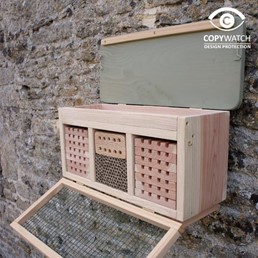
Dimensions: 27.5 x 52 x 26 cm.
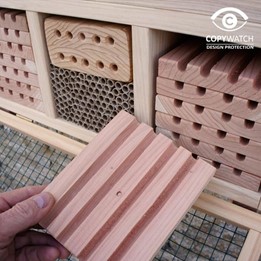
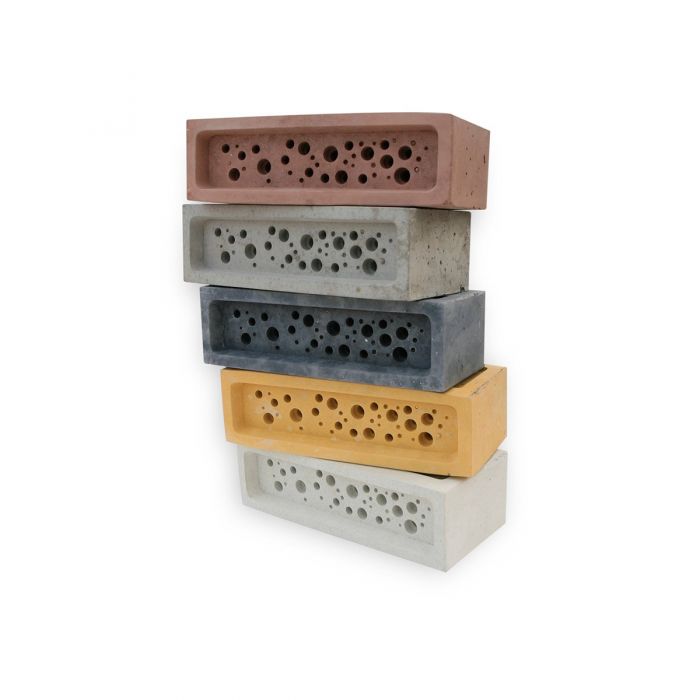
These bricks act as an ideal nesting site for solitary bees making a garden look aesthetically pleasing, as well as being a viable option to replace a standard brick in construction which creates more habitat for non-swarming solitary bees. This brick comes in a variety of colours to make an accommodating nesting site for red mason and leafcutter bees, amongst others to suit any bee-friendly garden, allotment, or building.
The Concrete Bee Brick should be put in a warm sunny spot, south-facing, with no vegetation in front of the fascia. It would be ideal to place it at least one meter from the ground with no upward limit.
The Bee Block aims to provide a safe, stylish nesting site for solitary bees. This block will suit any garden layout, fitting into the wall effortlessly to help provide a safe environment for the bees over many years. Solitary bees don’t produce honey or have a queen to protect; they have no reason to be aggressive which will help to create more of an interest in children and animals to be comfortable in the area.
The Concrete Bee Block is a perfect gift for the eco-conscious, a treat for your garden and a simple and stylish way to do something to help our declining bee population. If you’re interested in incorporating the bee brick into an extension, landscape project, new build, retrofit or another project, please contact us for a quotation.
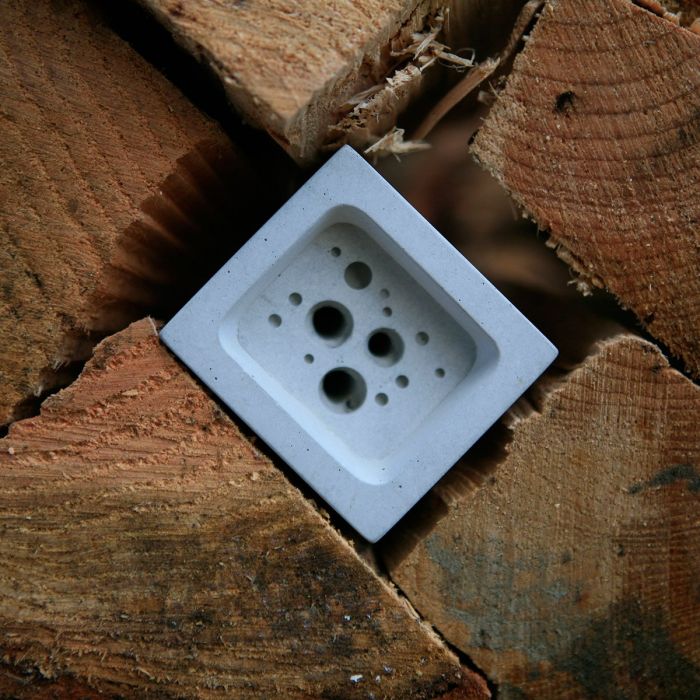
Sources:
USDA. (2017). Honey Bees. Available: https://www.aphis.usda.gov/aphis/ourfocus/planthealth/plant-pest-and-disease-programs/honey-bees/!ut/p/z1/04_iUlDg4tKPAFJABpSA0fpReYllmemJJZn5eYk5-hH6kVFm8X6Gzu4GFiaGPu6uLoYGjh6Wnt4e5mYGwa6m-uFgBT7-Js. Last accessed 15/03/2022.
University of California - Berkeley. (2006). Pollinators Help One-third Of The World's Food Crop Production. Available: https://www.sciencedaily.com/releases/2006/10/061025165904.htm#:~:text=Pollinators%20such%20as%20bees%2C%20birds,published%20today%20(Wednesday%2C%20Oct. Last accessed 15/03/2022.
The University of Reading. (2019). Centre for Food Security. Available: https://www.reading.ac.uk/web/files/food-security/cfs_case_studies_-_sustainable_pollination_services.pdf. Last accessed 15/03/2022.
Kew Royal Botanic Gardens. (2017). Why meadows matter. Available: https://www.kew.org/read-and-watch/meadows-matter. Last accessed 15/03/2022.
Built Environment Committee. (2021). Meeting housing demand. Available: https://committees.parliament.uk/publications/8354/documents/85292/default/. Last accessed 15/03/2022.
Bee Planet Foundation . (2021). We Need Bees . Available: https://www.planetbee.org/why-we-need-bees. Last accessed 25/04/2022.

